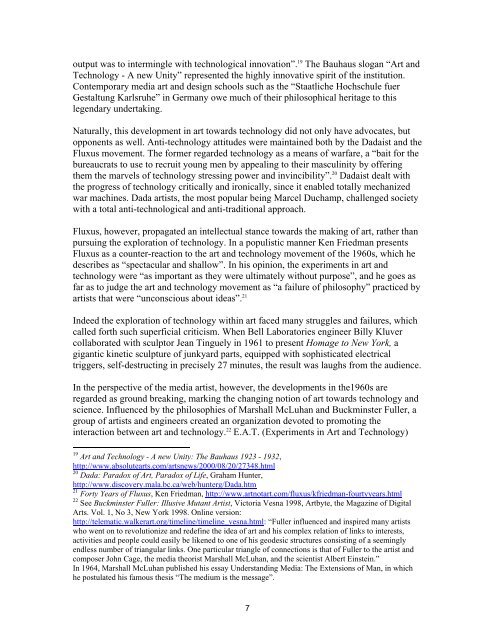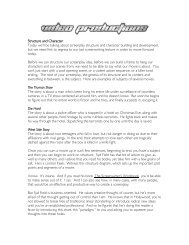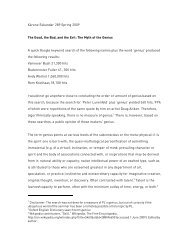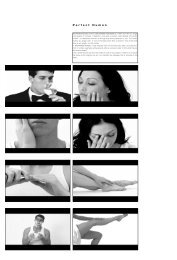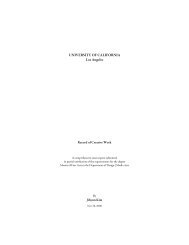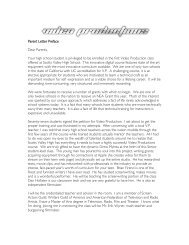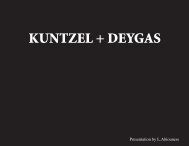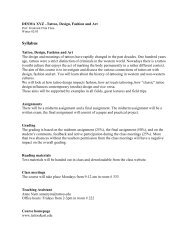Singing cells, art, science and the noise in between - Users - UCLA
Singing cells, art, science and the noise in between - Users - UCLA
Singing cells, art, science and the noise in between - Users - UCLA
You also want an ePaper? Increase the reach of your titles
YUMPU automatically turns print PDFs into web optimized ePapers that Google loves.
output was to <strong>in</strong>term<strong>in</strong>gle with technological <strong>in</strong>novation”. 19 The Bauhaus slogan “Art <strong>and</strong><br />
Technology - A new Unity” represented <strong>the</strong> highly <strong>in</strong>novative spirit of <strong>the</strong> <strong>in</strong>stitution.<br />
Contemporary media <strong>art</strong> <strong>and</strong> design schools such as <strong>the</strong> “Staatliche Hochschule fuer<br />
Gestaltung Karlsruhe” <strong>in</strong> Germany owe much of <strong>the</strong>ir philosophical heritage to this<br />
legendary undertak<strong>in</strong>g.<br />
Naturally, this development <strong>in</strong> <strong>art</strong> towards technology did not only have advocates, but<br />
opponents as well. Anti-technology attitudes were ma<strong>in</strong>ta<strong>in</strong>ed both by <strong>the</strong> Dadaist <strong>and</strong> <strong>the</strong><br />
Fluxus movement. The former regarded technology as a means of warfare, a “bait for <strong>the</strong><br />
bureaucrats to use to recruit young men by appeal<strong>in</strong>g to <strong>the</strong>ir mascul<strong>in</strong>ity by offer<strong>in</strong>g<br />
<strong>the</strong>m <strong>the</strong> marvels of technology stress<strong>in</strong>g power <strong>and</strong> <strong>in</strong>v<strong>in</strong>cibility”. 20 Dadaist dealt with<br />
<strong>the</strong> progress of technology critically <strong>and</strong> ironically, s<strong>in</strong>ce it enabled totally mechanized<br />
war mach<strong>in</strong>es. Dada <strong>art</strong>ists, <strong>the</strong> most popular be<strong>in</strong>g Marcel Duchamp, challenged society<br />
with a total anti-technological <strong>and</strong> anti-traditional approach.<br />
Fluxus, however, propagated an <strong>in</strong>tellectual stance towards <strong>the</strong> mak<strong>in</strong>g of <strong>art</strong>, ra<strong>the</strong>r than<br />
pursu<strong>in</strong>g <strong>the</strong> exploration of technology. In a populistic manner Ken Friedman presents<br />
Fluxus as a counter-reaction to <strong>the</strong> <strong>art</strong> <strong>and</strong> technology movement of <strong>the</strong> 1960s, which he<br />
describes as “spectacular <strong>and</strong> shallow”. In his op<strong>in</strong>ion, <strong>the</strong> experiments <strong>in</strong> <strong>art</strong> <strong>and</strong><br />
technology were “as important as <strong>the</strong>y were ultimately without purpose”, <strong>and</strong> he goes as<br />
far as to judge <strong>the</strong> <strong>art</strong> <strong>and</strong> technology movement as “a failure of philosophy” practiced by<br />
<strong>art</strong>ists that were “unconscious about ideas”. 21<br />
Indeed <strong>the</strong> exploration of technology with<strong>in</strong> <strong>art</strong> faced many struggles <strong>and</strong> failures, which<br />
called forth such superficial criticism. When Bell Laboratories eng<strong>in</strong>eer Billy Kluver<br />
collaborated with sculptor Jean T<strong>in</strong>guely <strong>in</strong> 1961 to present Homage to New York, a<br />
gigantic k<strong>in</strong>etic sculpture of junkyard p<strong>art</strong>s, equipped with sophisticated electrical<br />
triggers, self-destruct<strong>in</strong>g <strong>in</strong> precisely 27 m<strong>in</strong>utes, <strong>the</strong> result was laughs from <strong>the</strong> audience.<br />
In <strong>the</strong> perspective of <strong>the</strong> media <strong>art</strong>ist, however, <strong>the</strong> developments <strong>in</strong> <strong>the</strong>1960s are<br />
regarded as ground break<strong>in</strong>g, mark<strong>in</strong>g <strong>the</strong> chang<strong>in</strong>g notion of <strong>art</strong> towards technology <strong>and</strong><br />
<strong>science</strong>. Influenced by <strong>the</strong> philosophies of Marshall McLuhan <strong>and</strong> Buckm<strong>in</strong>ster Fuller, a<br />
group of <strong>art</strong>ists <strong>and</strong> eng<strong>in</strong>eers created an organization devoted to promot<strong>in</strong>g <strong>the</strong><br />
<strong>in</strong>teraction <strong>between</strong> <strong>art</strong> <strong>and</strong> technology. 22 E.A.T. (Experiments <strong>in</strong> Art <strong>and</strong> Technology)<br />
19 Art <strong>and</strong> Technology - A new Unity: The Bauhaus 1923 - 1932,<br />
http://www.absolute<strong>art</strong>s.com/<strong>art</strong>snews/2000/08/20/27348.html<br />
20 Dada: Paradox of Art, Paradox of Life, Graham Hunter,<br />
http://www.discovery.mala.bc.ca/web/hunterg/Dada.htm<br />
21 Forty Years of Fluxus, Ken Friedman, http://www.<strong>art</strong>not<strong>art</strong>.com/fluxus/kfriedman-fourtyyears.html<br />
22 See Buckm<strong>in</strong>ster Fuller: Illusive Mutant Artist, Victoria Vesna 1998, Artbyte, <strong>the</strong> Magaz<strong>in</strong>e of Digital<br />
Arts. Vol. 1, No 3, New York 1998. Onl<strong>in</strong>e version:<br />
http://telematic.walker<strong>art</strong>.org/timel<strong>in</strong>e/timel<strong>in</strong>e_vesna.html: “Fuller <strong>in</strong>fluenced <strong>and</strong> <strong>in</strong>spired many <strong>art</strong>ists<br />
who went on to revolutionize <strong>and</strong> redef<strong>in</strong>e <strong>the</strong> idea of <strong>art</strong> <strong>and</strong> his complex relation of l<strong>in</strong>ks to <strong>in</strong>terests,<br />
activities <strong>and</strong> people could easily be likened to one of his geodesic structures consist<strong>in</strong>g of a seem<strong>in</strong>gly<br />
endless number of triangular l<strong>in</strong>ks. One p<strong>art</strong>icular triangle of connections is that of Fuller to <strong>the</strong> <strong>art</strong>ist <strong>and</strong><br />
composer John Cage, <strong>the</strong> media <strong>the</strong>orist Marshall McLuhan, <strong>and</strong> <strong>the</strong> scientist Albert E<strong>in</strong>ste<strong>in</strong>.”<br />
In 1964, Marshall McLuhan published his essay Underst<strong>and</strong><strong>in</strong>g Media: The Extensions of Man, <strong>in</strong> which<br />
he postulated his famous <strong>the</strong>sis “The medium is <strong>the</strong> message”.<br />
7


